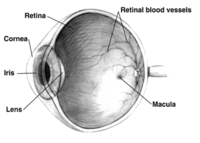
Photo from wikipedia
Despite notable efforts and significant therapeutical advances, age‐related macular degeneration remains the single most common reason for vision loss. Retinal progenitor cells (RPCs) are considered promising candidates for cellular treatments… Click to show full abstract
Despite notable efforts and significant therapeutical advances, age‐related macular degeneration remains the single most common reason for vision loss. Retinal progenitor cells (RPCs) are considered promising candidates for cellular treatments that repair and restore vision. In this allogenic study, the phenotypic profile of pig and human RPCs derived using similar manufacturing processes is compared. The long‐term (12‐week) survival of green fluorescent protein‐pig retinal progenitor cells GFP‐pRPC after subretinal transplantation into normal miniature pig (mini‐pig) retina is investigated. Human eyes are both anatomically and physiologically mimicked by pig eyes, so the pig is an ideal model to show an equivalent way of delivering cells, immunological response and dosage. The phenotypic equivalency of porcine and clinically intended human RPCs was established. Thirty‐nine mini‐pigs are used in this study, and vehicle‐injected eyes and non‐injected eyes serve as controls. Six groups are given different dosages of pRPCs, and the cells are found to survive well in all groups. At 12 weeks, strong evidence of integration is indicated by the location of the grafted cells within the neuro‐retina, extension of processes to the plexiform layers and expression of key retinal markers such as recoverin, rhodopsin and synaptophysin. No immunosuppression is used, and no immune response is found in any of the groups. No pRPC‐related histopathology findings are reported in the major organs investigated. An initial dose of 250 k cells in 100 µl of buffer is established as an appropriate initial dose for future human clinical trials.
Journal Title: Journal of Cellular and Molecular Medicine
Year Published: 2022
Link to full text (if available)
Share on Social Media: Sign Up to like & get
recommendations!